The following article was written by Mike Sloan and published in Renewable Energy World in 2005.
The Texas RPS policy – renowned internationally for its rapid success – derived from a Texas rulemaking process that employed a framework negotiated by a stakeholder task force co-chaired by Mike Sloan and Ward Marshall (reunited again to innovate at Synergetic).
Some elements of the RPS have worked well; yet in other ways, the Standard could be considered a failure
THE TEXAN CONTEXT
Texas is a big state in the southern US, bordering on Mexico, and is diverse in geography, culture and climate. Once an independent nation,Texas still retains a strong sense of identity and self-determination; it is the second most populous state in the country, with major cities such as Houston, Dallas, San Antonio and Austin in the east, though the west remains rural and lightly populated. Coupled with an unmatched industrial energy sector – predominantly petroleum refineries and chemical plants along its eastern coast – Texas is among the most energy-intensive regions in the world. Table 1 gives an overview of the state.
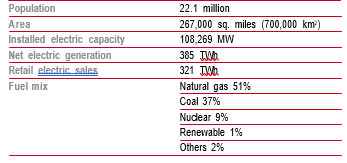
Table 1. Texas basics. Source: Electricity – U.S. Energy Information Administration (EIA)
One of Texas’ newest wind projects is a 160 MW collaboration between Cielo, Orion, Shell, TXU and Green Mountain that, in part, serves voluntary retail renewable energy purchases Cielo Wind Power
Texan energy culture
In 1901, a Texas oil well named Spindletop delivered an unprecedented ‘gusher’, and began an era of cheap, abundant oil. Production of oil and natural gas became a cornerstone of the Texan economy, delivering considerable benefits in terms of employment, wealth creation and taxes.While production of both oil and natural gas in Texas peaked in 1972, Texans continue to embrace the energy industry. But Texas doesn’t just produce energy, it also consumes energy – a lot of it. In fact, Texas uses more electricity, petroleum, natural gas, coal and total energy than any other state in the US.
Texas is also blessed with an abundance of renewable energy potential, ranking number one in solar and biomass and number two in wind energy potential among the conterminous states.1 In contrast with this impressive portfolio of available resources, the state’s actual use of renewable energy was historically very small – only 0.7% in 1994, for instance – placing it 51st in the US, behind every other state and the District of Columbia.
Many aspects of Texan energy culture – high energy use, acceptance of large energy production projects, and preference for no-nonsense, pro-business rules – have provided a fertile environment for renewable energy’s success. But the state still needed a catalyst to give renewables a serious chance of success. That opportunity arose when Texas began to use more energy than it produced – it became a net importer of energy in 1992, after which state officials were soon motivated to look for solutions which would reverse the situation.
Of course, in Texas, the first reaction to becoming a net importer of energy was to encourage the drilling of more wells. After all, this is a state where ‘green power’ is defined as ‘electricity generated from Texas natural gas’.2 But persistent efforts by the renewable energy community, environmental and consumer advocates – as well as some electric utilities and state leaders – resulted in a series of incremental steps that eventually led to the acceptance of wind power and other renewable energy sources as legitimate energy options for Texas.
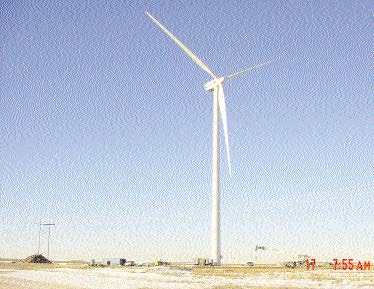
Texas-sized turbines – at 3 MW, this Vestas V90, installed near the Oklahoma border in Hutchinson County, Texas during 2003, is the largest wind turbine in North America Great Plans Wind
In Texas, ‘green power’ is defined as electricity generated from local natural gas
Utility polls change Texas
One of the critical steps in the evolution of Texan renewables was the requirement, initiated as part of a 1995 Integrated Resource Planning (IRP) law, that electric utilities seek input from their customers regarding future resource procurement decisions. The intensive ‘Deliberative Polling’TM process was first used by Central and Southwest Services (now AEP) in 1996, and this process quickly became the standard for all utilities in Texas to ascertain customer preferences.
Eight of the nine investor-owned utilities in Texas, representing two thirds of electric customers in the state, used this process between 1996 and 1998, and each found widespread public support for renewable energy (Table 2 gives a summary of results).The polls found customers across Texas preferred renewable energy over other sources, and were willing to pay extra for more clean energy. More importantly, the process enlightened utility decision-makers and regulators on what Texan customers wanted.
When the Texas Legislature took up electric industry restructuring in 1999, the compelling information on customer attitudes towards renewable energy ensured that this resource would be given serious consideration. Coupled with more than $100 million worth of IRP-related wind projects under development during the spring of 1999, and an intensive lobbying effort by the renewable energy industry, a Renewable Portfolio Standard (RPS) became an important component of the sweeping electric industry reforms approved by the Texas Legislature in May 1999.
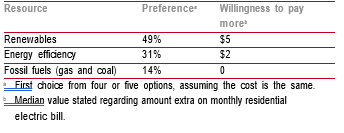
Table 2. Texas Deliberative PollTM: key results (weighted average results for eight largest investor-owned utilities).
THE RENEWABLE PORTFOLIO STANDARD
Prior to Texas, no state had succeeded in implementing a functional RPS. The Texas Legislature developed the basic guidance for the RPS, but left the details to the state’s utility regulatory body – the Public Utility Commission of Texas (PUCT). Partly because the Legislature only allowed regulators seven months to complete programme details (i.e. everything needed to turn a few paragraphs of legislation into a functioning programme), the PUCT convened a Stakeholder Working Group that attempted to reach consensus on the structural framework and details of the RPS design before a rule was drafted by regulatory staff.When stakeholders hit an impasse and were unable to resolve key threshold issues, such as whether renewable energy credits should be issued based on energy or capacity, and how existing resources should be treated, the PUCT Commissioners made intermediate decisions to provide guidance.Thanks to its ethic of valuing functionality, and the capabilities of an exceptionally talented group of regulators and staff, Texas succeeded in developing a streamlined set of effective RPS rules by the end of 1999.
Guided by a clear understanding of their respective responsibilities, electric utilities in Texas did a commendable job of renewable resource procurement, and developers followed through on installation. The Texas RPS serves as an impressive example of what effective renewable energy policies can deliver: from concept to law to $1 billion worth of results in less than three years.Table 3 provides a summary of key events that occurred prior to the programme’s first compliance year (2002)
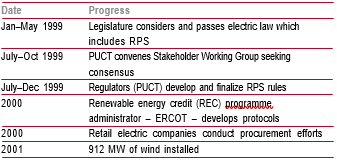
Table 3. Texas RPS Performance: 0–912 MW in less than three years
The Texas RPS serves as an impressive example of what effective policies can deliver: from concept to $1 billion worth of results in less than three years
THE RENEWABLE PORTFOLIO STANDARD
In its most rudimentary form, the Texas RPS sets an escalating set of renewable energy goals for the state and places responsibility for meeting those goals on a limited group of stakeholders.The key elements of Texas’five-step RPS approach are as follows:
- specify the mandate – ramp-up to 2000 MW of new renewables by 2009
- assign responsibility – to electric retailers in the competitive market
- compel performance – assign meaningful penalties for non-compliance
- track compliance – use renewable energy credits (RECs) with a single ‘cradle-to-grave’ administrator
- manage the details – establish clear, functional rules.
The Texas Legislature desired that the state continue to use its portfolio of 880 MW of existing renewable resources, and also specified minimum additions of new resources in future years, as shown in Table 4. The unusual quantity of resources specified in the Texas RPS legislation derived from a political deal struck between key stakeholders. This was politically expedient at the time, but has led to a number of complicating factors. These include the need for minimum performance standards and use of an adjustable capacity conversion factor (CCF) to turn megawatt goals into megawatt-hour requirements that can be substantiated through REC retirements, the latter proving contentious because entities buying RECs want the CCF to be low and those selling RECs want it to be high.This is one feature of the Texas RPS that is unnecessarily complicated, and percentage RPS goals should be used whenever possible.
In the basic mechanics of the Texas RPS’s operation, electricity retailers must acquire RECs in proportion to their share of statewide load (competitive market only), with adjustments made based on historical use of existing renewables (so-called ‘REC offsets’). In all cases, RECs can only be obtained from renewable generation sources certified by the state of Texas. Retailers that are not in compliance are subject to significant penalties of up to $50/MWh (5 cents/kWh). This market-based approach should work smoothly, so long as market participants make long-term commitments.

The 160 MW Green Mountain Energy Wind Farm at Brazos CIELO WIND POWER
The Texas RPS has been very good for wind, but has been a virtual ‘dry hole’ for resources such as photovoltaics and solar water heating

Table 4. Texas RPS – minimum resource requirements
Results: renewable energy development
Figure 1 compares the RPS targets with the actual capacity installed since the scheme has been in operation, while resources registered for the Texas renewable energy credit (REC) trading programme are identified in Table 5. As can be seen from the latter, the Texas RPS has had different impacts on the different renewable energy technologies: it has been very good for low-cost renewables such as wind and, to a lesser extent, landfill gas, but has been a virtual ‘dry hole’ for resources such as photovoltaics and solar water heating, which need more support. Collectively, new renewable energy facilities produce approximately 1% of the electricity in Texas.
With exceptional wind sites, substantial energy demand and high marginal costs for electricity,Texas is probably one of the best places in the world to develop wind power.The wind industry has responded to the Texas RPS by building some of the largest (up to 280 MW) and lowest-cost (under 3 cents/kWh, with federal incentives) wind projects in the world. Figure 2 shows wind projects and installed capacity in Texas, and Figure 3 shows potentially viable wind development zones in relation to the utility grids of the state. In contrast, the Texas RPS has done virtually nothing to stimulate development of small-scale, customer-sited renewables. Consequently, without any other significant state incentives, solar and other small-scale resources have been slow to progress in Texas.
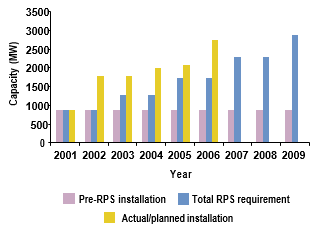
Figure 1. Texas RPS: targets and actual, cumulative installations. Values given are for 1 January of specified year; 2005 value anticipated at time of going to press. Actual installation at 1 January 2006 predicted to be between 2500 MW and 3000 MW – an average of 2750 MW is shown.
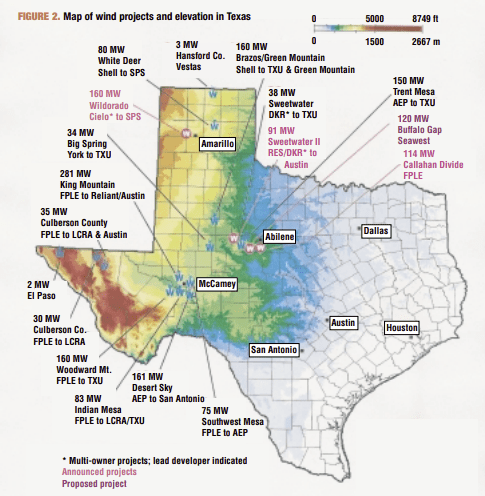
Figure 2. Map of wind projects and elevation in Texas
More on the way
The US federal Production Tax Credit (PTC) for wind-generated electricity was reinstated as part of House Bill 1308 (Tax Extender bill) and signed into law by President Bush on 4 October 2004.This has already stimulated intense activity to complete projects in Texas and surrounding states (specifically within ERCOT and the Southwest Power Pool [SPP]) by the end of 2005.Texas will likely be adding several hundred megawatts of additional wind capacity, over and above the 365 MW recently announced (see Table 6). Substantial additional wind development is also expected in nearby New Mexico, Oklahoma and Kansas, states which are, like Texas, seeking to take advantage of the
PTC and available transmission capacity. A substantial portion – perhaps over half – of US wind development during 2005 will occur within these four states.

Table 6. Recently announced wind projects in Texas
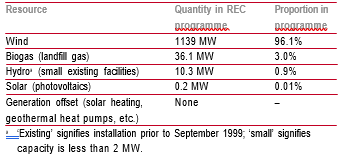
Table 5. Renewable capacity in the Texas REC programme, 1 January 2004
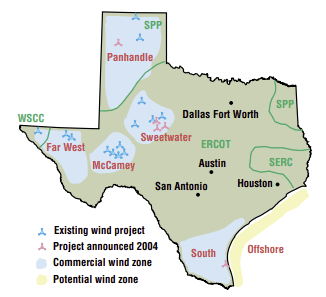
Figure 3. Commercial wind zones in Texas. Grid operators: ERCOT – Electric Reliability Council of Texas; SPP – Southwest Power Pool; SERC – Southeast Reliability Council; WSCC – Western States Coordinating Council.
LESSONS LEARNED
The main lessons that the Texas RPS offers for the development of RPS in other states and countries are:
- Include flexibility mechanisms – priming the market with flexibility mechanisms such as early banking induces a healthy supply of RECs for the RPS and for voluntary markets.
- Expect voluntary markets – a successful RPS is an effective foundation for stimulating a broader renewable energy market, based on voluntary actions.
- Companion transmission needed – an RPS in regions with weak to moderate grids needs an accompanying transmission plan.
- Consider resource diversity – as a sole renewable energy policy, an RPS will tend to promote only the most cost- effective resource(s), unless provisions are included to stimulate diversity.
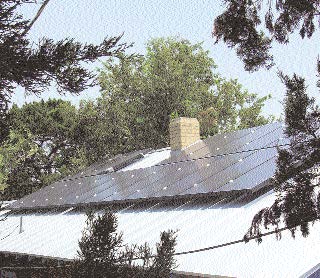
A modest start for solar – in response to urging from the local community, Austin Energy has initiated Texas’ first PV rebate programme, which may well trigger bigger things for solar electricity throughout the state Meridian Energy Systems
Flexibility mechanisms
Three RPS flexibility mechanisms ensured the system was sufficiently primed with RECs during its infancy to have a chance of success. These mechanisms were:
- early banking’ of RECs that were generated up to six months prior to the start of the first RPS compliance year
- a small REC ‘deficit allowance’ of up to 10% for retailers during the first two compliance years
- a two-year ‘REC banking’ provision
An interesting observation is that a minority of electric retailers in Texas – generally only the largest, most firmly established utility players – have opted to enter long-term contracts to procure renewable resources directly. Most retailers with RPS obligations are instead relying exclusively on the secondary REC market, meeting their needs through brokers, or buying from companies with long-term renewable energy contracts. Many of the retailers dependent on the REC spot market have accused those with credits of ‘REC hoarding’, and have sought state action to have multi-year banking provisions eliminated. One motivation for doing so is simply to lower REC prices during times of surplus.This is a dangerous policy change, however, as it would increase price volatility and lead to soaring prices when RECs are in short supply. Use of some flexibility measures should be encouraged as a permanent feature of any REC programme.
Further observations
The most contentious and difficult RPS design issue proved to be how best to accommodate renewable energy resources that had been developed prior to the RPS (primarily old hydro power facilities), without jeopardizing the nascent REC market, which was primarily intended to incentivize development of new resources. The compromise devised by regulators was to issue so-called ‘REC offsets’ to older renewable energy facilities. These offsets reduce, on a megawatt-hour for megawatt-hour basis, the quantity of RECs that have to be procured by a retailer which is supplied in part by older renewable facilities, but the offsets may not be traded to others.This policy seems to be passing the test of time, and is endorsed as a reasonable solution to a thorny issue.
TEXAS RECS: BEYOND THE RPS
With a quality foundation laid by the Texas RPS, a more robust and diversified renewable energy market has emerged, based on voluntary actions. Renewable Energy Credits (RECs) administered by the Electric Reliability Council of Texas (ERCOT) were initially envisioned as the currency for validating compliance with the RPS. Almost immediately, however, these renewable ‘certificates of authenticity’ were identified as having a broader application, and in 2000, ERCOT developed within its protocols the provisions for two categories of REC retirement: ‘RPS Compliance’ and ‘Voluntary’.³

Installing an Austin Energy solar system at the New City Hall, Austin that was opened in November 2004 Austin Energy
Some flexibility measures should be encouraged as a permanent feature of any REC programme
Voluntary green power sales
The flexibility of RECs has enabled companies to substantiate green power sales quite easily.The availability and affordability of Texan RECs has in fact led to Texas becoming the nation’s leader in such sales. The state boasts the leading green programme offered by a regulated utility (Austin Energy’s Green Choice), the nation’s leading competitive retailer of renewable energy (Green Mountain Energy), which has more than 50,000 Texan customers, and some of the largest retail customers of green power (such as Dyess Air Force Base in Abilene,Texas, which buys nearly 100,000 MWh of renewables per year – more than most US utility’s total green sales). The voluntary green market has definitely taken root in Texas, with total voluntary retirement of Texan RECs jumping from 231,000 in 2002 to nearly 800,000 in 2003 (an increase of nearly 250%).
Public power forges ahead
The renewable energy activities of these community- owned utilities can be largely credited to the vigorous efforts of community advocates. In Austin, the state’s first PV rebate programme got underway in the summer of 2004; though modest at present, it is expected to contribute to a significant city solar goal of 15 MW by 2007. Meanwhile, compensation for City Public Service of San Antonio is now linked to the performance of the utility in meeting specific renewable energy goals (i.e. the bonus is directly linked to meeting the renewable energy goal), a development due in part to the tireless efforts of Solar San Antonio.4
TRANSMISSION: WINGD’S BIGGEST CHALLENGE
Whereas the Texas RPS has served as an effective catalyst for renewables, the state’s transmission development practices are currently undermining more robust expansion of wind power.
McCamey – wind power capital of Texas
The word ‘McCamey’ has come to symbolize the challenges of having more wind capacity installed than can be exported to the grid. By the end of 2001, the ‘mesas’ (plateaus) surrounding this west Texas oil patch town served as host to 755 MW of wind turbines, clustered into some of the largest wind projects on Earth. Unfortunately, the transmission system at that time could export a maximum of only 330 MW.This led to frequent, involuntary curtailment of wind production; upgrades to fix current problems commonly exacerbate the situation, since lines are typically taken out of service while being upgraded. Wind project owners had expected transmission shortages and subsequent curtailment problems to be rectified much more quickly.This situation is being solved in incremental steps, and McCamey should be able to export perhaps 600–700 MW of wind generation by mid-2005.
Texan transmission development practices are undermining more robust wind expansion
ERCOT’s McCamey plan
With transmission expenses spread among all customers via uniform ‘postage stamp’ pricing (regardless of distance to the load), ERCOT is considered to have the most developer- friendly transmission rules in the US. Yet the fact that transmission lines take much longer to design, permit and construct (about five to seven years) than wind power (one or two years) creates a ‘chicken and egg’ situation for development, one that Texas has simply not been able to overcome in the five years since the RPS became law.
In May 2003, ERCOT adopted a plan to construct two 345 kV transmission lines to tie the remote McCamey area in with ERCOT’s high-voltage grid.This plan, at an estimated cost of $155 million, would enable 1100 MW of additional wind capacity to be added to the system. The 40% capacity factor wind sites in the area should result in incremental transmission costs equivalent to approximately 0.6 cents/kWh of wind supported. With wind contracts in the area available for less than 3 cents/kWh (with PTC), the cost of wind plus transmission should still be cheaper than natural gas-fuelled power (an estimated 4–6 cents/kWh during the next five years). Figure 4 compares trends in wind and natural gas prices.
Proceeding with these transmission lines may seem like an obvious decision, but as there is intense focus on short-term costs within ERCOT’s competitive market, it remains difficult to achieve long-term investments such as those needed for transmission lines and wind power facilities. Moreover, the requirement in ERCOT’s ‘McCamey Plan’ that needed lines to be 100% subscribed with wind interconnection agreements prior to initiation of the five-year transmission development process has proven an insurmountable hurdle. Recently, ERCOT’s transmission planning staff recommended that the ERCOT Board reconsider this plan.
Unless transmission owners can get assurances that they will recover their investment, the incentive to build new infrastructure in Texas will remain tenuous. Moreover, if they are to proceed on a project, wind developers must present an opportunity that is appealing to financiers. Bankers simply will not invest in wind projects where no transmission line exists, unless there is a very high level of certainty the line will appear in a defined period of time. The state of Minnesota has been most successful in addressing this situation, by conditionally approving construction of new transmission facilities to serve the south-western part of the state, without requiring that there first be wind interconnection agreements in place. For Texas, the inability to make any progress on the ‘chicken and egg’ transmission situation is a failure that poses a grave threat to future growth of the Texan renewable energy sector.
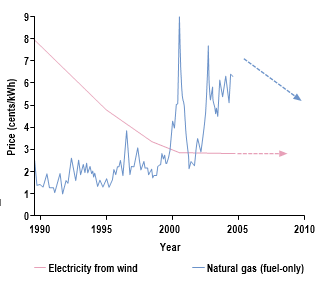
FIGURE 4. Comparison of wind and natural gas prices. Gas prices are depicted as a power plant ‘fuel-only’ cost assuming a heat rate of 10,000 BTU/kWh, the average heat rate of gas power plants in Texas during the 1990s. With the big boom in natural gas combined-cycle plants during the past five years, the average is now about 8500 TU/kWh. Source: Gas projections based on NYMEX futures contracts, historical record based on NYMEX spot marke
Bankers simply will not invest in wind projects where no transmission line exists

Fixing the problem
Proactive transmission planning is needed to add renewable energy in the most cost-effective manner. Overcoming the historical obstacles to successful development of transmission infrastructure to support wind power, a four-stage process should be employed:
- state regulators should work with the wind industry to identify ‘competitive wind zones’ within the state
- transmission owners should be authorized to undertake and recover the costs associated with the planning, design, right-of-way acquisition and permitting of infrastructure needed to harvest wind energy from identified zones
- renewable generators should be encouraged to utilize the infrastructure project, such as via a request for proposals or an open season
- transmission line construction should proceed when a reasonable quantity of resources is expected to use the line, whether through direct subscription (interconnection agreements) or to satisfy a state policy goal (such as RPS targets).
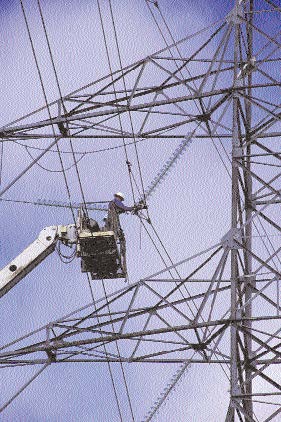
WHERE TEXAS GOES NEXT
The Texas RPS has been a gusher of success for initial wind development, but the state has, in contrast, been ineffective in proactively developing the transmission lines needed for wind to expand in a sustainable way. Meanwhile, the RPS has been a virtual dry hole for solar and other small-scale renewable resources. Looking ahead, Texas will need proactive transmission planning and mechanisms to stimulate renewable resource diversity if it is to significantly develop its tremendous renewable resource base.
Mike Sloan is President of Virtus Energy Research Associates, Inc. and is Managing Consultant for The Wind Coalition. He served as co-chair of the Texas stakeholder advisory group that helped craft the structural framework for the Texas RPS.
Fax: +1 512 476 9896
e-mail: sloan@vera.com
NOTES
- Texas Renewable Energy Resource Assessment: Survey, Overview and Recommendations. www.vera.com/ re_b_psdoc_01.htm
- Texas Public Utility Regulatory Act, 39.9044(d)(2) Goal for Natural Gas.
- Retirement is a key issue for Credits are created (issued), and then there is a trading period (lasting for the remainder of the year the REC was produced plus two additional compliance years), and then they are finally ‘used’, by turning them in to the programme administrator, who removes (retires) them from the trading programme. RECs have no value to legitimize a claim (for RPS compliance, green pricing, emission reduction etc.) until they are retired in this way.
- See www.solaraustin.org and www.solarsanantonio.org respectively.

